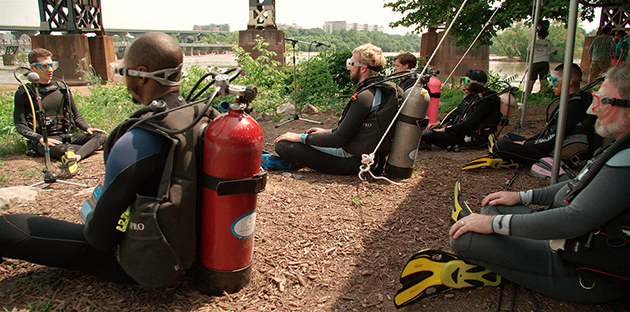USF Contemporary Art Museum Presents Two Free Public Art Programs in Tarpon Springs
Thursday, February 20, 2020

On Sunday, February 23, the USF Contemporary Art Museum, part of the USF Institute for Research in Art in the College of The Arts, will present two FREE public programs, an artist talk and public performance in Tarpon Springs in association with artist Hope Ginsburg’s Sponge Exchange exhibition, on view through March 7th.
Artist Talk with Hope Ginsburg at Leepa-Rattner Museum of Art
Sunday, February 23, 2020 at 3 p.m.
600 E. Klosterman Rd, Tarpon Springs, Florida 34689
Dive deeper into the practice of artist and educator Hope Ginsburg as she presents on her past and current interdisciplinary projects which explore the sponge as a model for knowledge exchange, a catalyst for social and ecological change. Presented in partnership with the Leepa-Rattner Museum of Art. Free publ
Land Dive Team: Tarpon Springs public performance at The Sponge Exchange
Sunday, February 23, 2020 at 6 p.m.
735 Dodecanese Blvd, Tarpon Springs, Florida 34689
The fourteenth performance in artist Hope Ginsburg’s series of sited meditations, Land Dive Team: Tarpon Springs aims to stimulate attention and dialogue around the climate crisis, our relationship to it, and its impact on our lives and future. Engaging trained participants meditating in scuba gear on land, the performance proposes the practice of present moment awareness.
Accompanied by a live musical score integrating the breath of composer Joshua Quarles and the land divers into the amplified, immersive soundscape, Land Dive Team: Tarpon Springs invites audiences to participate in the meditative and collective breathing practice as a tool for coping with the mental and emotional challenges of living in a radically changing environment. Located within the Tarpon Springs’ Sponge Exchange, where sponges were historically traded, the performance taps into the former function of the space as a site of exchange to stimulate social transformation.
Presented in partnership with The Sponge Exchange, Tarpon Strings Music and Turn the Tide for Tarpon.
About Sponge Exchange
Sponge Exchange expands artist Hope Ginsburg’s work with ecology and knowledge transfer in two new collaboratively-produced video and sculpture installations. Swirling, a four-channel video created in collaboration with diver/videographer Matt Flowers and composer Joshua Quarles, and produced with support of the Wexner Center for the Arts Film/Video Studio Program, submerges viewers in the underwater coral nurseries and outplant sites of St. Croix, capturing the often-unseen coral farming and reef restoration work that occurs beneath the surface.
The exhibition also features a series of dioramas inspired by the idiosyncratic and educational dioramas of Tarpon Springs’ Spongeorama Museum. Created in collaboration with USF School of Art and Art History students during a fall semester class co-taught by Ginsburg and USF Associate professor John Byrd, the three-dimensional dioramas examine issues marine species are facing due to the effects of our climate crisis, in order to raise awareness and understanding of how the health of marine invertebrates is deeply tied to the environment and economic life of our region, and to serve as a catalyst for imagining productive solutions for the future. Archival materials and ephemera from Ginsburg’s decade-long exploration of the sea sponge as a pedagogical model for interdisciplinary and participatory learning are also on view. Sponge Exchange is supported by the National Endowment for the Arts Art Works grant and The Andy Warhol Foundation for the Visual Arts.
About the Artist
Hope Ginsburg creates interdisciplinary projects which are invested in the socially transformative potential of knowledge exchange, and which build community around learning. Ginsburg’s work is driven by a curiosity about the natural world, its materials and the species with which we share the planet. Her on-going projects are collaborative, cooperative, and participatory, often organized around live experiences for those directly involved, resulting in visual representations, objects, photography and videos.